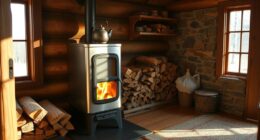Repeatedly, I have witnessed a neglected wood stove leading to hazardous creosote accumulation and diminishing its effectiveness.
But how often should you clean out your wood stove to prevent these issues?
In this article, I’ll share my expertise and experience to guide you through the proper cleaning frequency for various types of wood stoves.
So, if you’re ready to keep your wood stove running smoothly and safely, let’s dive in!

Key Takeaways
- Regular maintenance of a wood stove is important for improving efficiency and ensuring safe operation.
- Signs that indicate the need for cleaning include increased smoke production and decreased heat output.
- Proper cleaning involves removing ashes and debris, cleaning the glass door, inspecting and replacing damaged gaskets, and wiping down the exterior.
- The recommended cleaning frequency for different types of wood stoves varies, but generally, pellet stoves should be cleaned weekly during the heating season, while chimney maintenance for wood stoves should be done annually.
The Importance of Regular Maintenance
I really understand the importance of regular maintenance for keeping my wood stove in good condition. One of the advantages of professional cleaning services is that they have the expertise and tools to thoroughly clean the stove, removing any buildup of soot, ash, and creosote. This not only improves the efficiency of the stove but also reduces the risk of chimney fires.
Another common mistake to avoid during wood stove maintenance is neglecting to clean the flue and chimney. Over time, these can become blocked with debris, which can cause smoke to back up into the house or even lead to carbon monoxide poisoning.
Regular maintenance also involves checking for any damage or wear and tear, such as cracked bricks or warped seals, and addressing them promptly to ensure safe and efficient operation.
Signs Your Wood Stove Needs Cleaning
To ensure safe and efficient operation, it’s important to regularly clean out your wood stove. This is especially necessary if you notice an increase in smoke production or a decrease in heat output. These warning signs indicate a buildup of creosote, ash, and other debris that can obstruct the airflow and decrease the stove’s performance.

Regular maintenance is crucial to prevent potential hazards such as chimney fires and carbon monoxide leaks. By following a maintenance checklist, you can keep your wood stove in optimal condition. This includes inspecting the chimney for any blockages, checking the gaskets and seals for wear and tear, and cleaning the stovepipe and firebox.
Properly cleaning your wood stove not only ensures its longevity but also contributes to its efficiency and safety.
How to Properly Clean Your Wood Stove
Cleaning your wood stove thoroughly at least once a year is essential for maintaining its efficiency and preventing potential hazards. As someone who’s been using a wood stove for several years, I’ve learned the importance of proper cleaning techniques and the common mistakes to avoid.
Here are some tips to help you properly clean your wood stove:

- Start by allowing the stove to cool completely before cleaning.
- Remove all ashes and debris from the firebox using a scoop or shovel.
- Clean the stove’s glass door using a non-abrasive cleaner to remove soot and grime.
- Inspect the stove’s gaskets and replace any damaged ones to ensure a tight seal.
- Finally, give the exterior of the stove a thorough wipe down to remove any dust or dirt buildup.
Recommended Cleaning Frequency for Different Types of Wood Stoves
While cleaning frequency for different types of wood stoves may vary, it’s important to follow the manufacturer’s recommendations to ensure optimal performance.
When it comes to pellet stoves, regular cleaning is essential for efficient operation. These stoves should be cleaned at least once a week during the heating season. This includes emptying the ash pan, removing any accumulated ash or debris from the burn pot, and cleaning the glass window.
Additionally, chimney maintenance for wood stoves is crucial to prevent chimney fires and ensure proper ventilation. The chimney should be inspected annually and cleaned as needed, typically every one to two years. Creosote buildup should be removed to maintain a safe and efficient wood stove.
Regular maintenance and cleaning won’t only prolong the lifespan of your wood stove, but also keep it running at its best.

Tips for Maintaining a Clean and Efficient Wood Stove
I’ve found that regularly cleaning the ash pan and removing debris from the burn pot are key tips for maintaining a clean and efficient wood stove.
Here are a few other tips I’ve learned over the years:
-
Clean the chimney and flue regularly to prevent creosote buildup, which can lead to chimney fires.
-
Use dry, seasoned wood to minimize the amount of soot and creosote produced during burning.

-
Avoid overloading the stove with too much wood, as this can restrict airflow and lead to incomplete combustion.
-
Never dispose of ashes in a combustible container or near flammable materials, as they can remain hot for days.
-
Lastly, always use appropriate safety precautions, such as wearing gloves and using a fire-resistant ash bucket, when cleaning your wood stove.
By following these tips, you can prevent wood stove fires and avoid common mistakes when cleaning your wood stove.

Stay safe and enjoy the warmth and comfort of your wood stove!
Frequently Asked Questions
How Can I Tell if My Wood Stove Needs Cleaning?
If you’re wondering if your wood stove needs cleaning, there are some signs to look out for. Soot buildup, reduced heat output, and a smoky smell are all indicators that maintenance is needed.
What Are the Potential Dangers of Not Cleaning My Wood Stove Regularly?
Neglecting wood stove cleaning can be dangerous. Regular maintenance is crucial to prevent potential hazards. Failure to clean can lead to chimney fires, poor air quality, and damage to the stove itself.
Can I Use Any Type of Cleaning Product or Solution to Clean My Wood Stove?
I’ve found that using a gentle cleaning solution, like a mixture of vinegar and water, is effective for cleaning my wood stove. It’s important to avoid harsh chemicals that can damage the stove.

Is It Necessary to Hire a Professional to Clean My Wood Stove, or Can I Do It Myself?
I’ve cleaned my wood stove myself many times. It’s a DIY task that requires some time and effort, but it’s definitely doable. However, hiring a professional has its benefits too. Let’s explore the pros and cons.
Are There Any Specific Safety Precautions I Should Take When Cleaning My Wood Stove?
When cleaning my wood stove, I always prioritize safety. I wear heat-resistant gloves, use a metal brush and ash shovel, and ensure the stove is completely cooled before starting. Safety first!
Conclusion
Cleaning your wood stove regularly is absolutely essential for maintaining its efficiency and ensuring a safe and enjoyable experience. Neglecting this crucial task can lead to a buildup of creosote, decreased heating performance, and even potential fire hazards.
By following the recommended cleaning frequency and properly maintaining your wood stove, you can enjoy a cozy and efficient fire that will keep you warm all winter long.

Don’t underestimate the power of a clean wood stove – it can truly transform your heating experience!
Growing up surrounded by the vast beauty of nature, Sierra was always drawn to the call of the wild. While others sought the comfort of the familiar, she ventured out, embracing the unpredictable and finding stories in the heartbeat of nature.
At the epicenter of every remarkable venture lies a dynamic team—a fusion of diverse talents, visions, and passions. The essence of Best Small Wood Stoves is crafted and refined by such a trio: Sierra, Logan, and Terra. Their collective expertise has transformed the platform into a leading authority on small wood stoves, radiating warmth and knowledge in equal measure.











